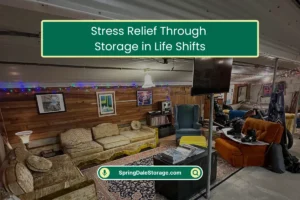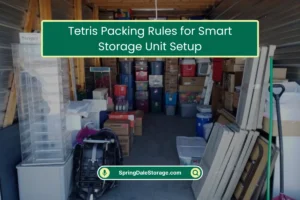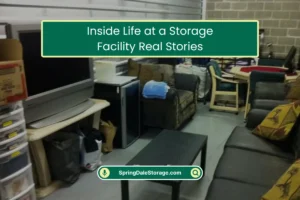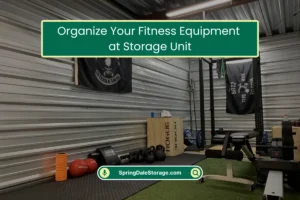Look, I get it – you’ve got that beautiful oak dining set from your grandparents or maybe that solid mahogany dresser you scored at a flea market. And now life’s throwing you a curveball where you need to store it somewhere without a perfect temperature and humidity control environment. Panic mode? Not so fast.
I’ve been there myself – storing furniture in garages, basements, and storage units that weren’t exactly museum-quality. Learned some hard lessons (RIP to that 1920s vanity that warped beyond recognition), but also figured out what actually works. Here’s the no-BS guide to keeping your wood furniture safe when you don’t have climate control unit.
First Things First: Know Your Enemy
Wood’s three worst nightmares:
- Moisture – Causes warping, mold, and that lovely musty smell.
- Dryness – Leads to cracking and splitting.
- Temperature swings – Makes wood expand and contract like it’s doing yoga.
Cleaning: Don’t Skip This (Seriously)
I made this mistake once. Stored a coffee table after just dusting it. Six months later? Sticky residue had turned into a permanent finish. Here’s how to do it right:
- For finished wood: Mix 1/4 cup white vinegar with a quart of warm water. Dampen (don’t soak) a microfiber cloth and wipe down every surface. Dry immediately with another clean cloth.
- For unfinished wood: Use a barely damp cloth with just water, then dry thoroughly. Maybe even hit it with a hairdryer on low if you’re paranoid (I’ve done this).
Pro tip: Get into all the nooks and crannies with an old toothbrush. Dust bunnies in carvings turn into moisture traps.
Disassembly: Your Secret Weapon
That bookshelf that took you three hours to assemble? Take it apart. Your future self will thank you when:
- It takes up less space (saving you money on storage).
- It’s less likely to get damaged.
- You don’t have to play “where does this weird piece go?” later.
What to take apart:
- Table legs (wrap each one individually).
- Bed frames (label EVERYTHING).
- Bookshelf shelves.
- Anything with drawers (take them out).
Storage hack: Put all hardware in a ziplock bag, label it with painter’s tape, and tape it to the largest piece. Because searching for that one screw in six months is nobody’s idea of fun.
Wrapping: What Actually Works
Plastic wrap = bad. Really bad. I learned this the hard way when I wrapped a dresser in plastic sheeting and came back to a science experiment.
Good options:
- Moving blankets (the quilted kind).
- Old cotton sheets (the tighter the weave, the better).
- Furniture pads (worth the investment if you have nice pieces).
Wrap job checklist:
- Cover sharp edges with foam pipe insulation (cheap at hardware stores).
- Wrap each piece separately.
- Secure with twine or fabric straps – no tape directly on the wood.
The Floor is Lava (For Your Furniture)
Concrete floors might as well be sponges when it comes to moisture. Here’s how to keep your pieces high and droughty:
Best options:
- Wooden pallets (free if you know where to look).
- 2×4 lumber laid out in a grid.
- Those interlocking garage floor tiles.
What NOT to use:
- Cardboard (it absorbs moisture).
- Directly on concrete (just don’t).
- Plastic sheeting (creates condensation).
Moisture Control Tricks That Actually Work
After trying every hack on Pinterest, here’s what’s actually effective:
Budget options:
- Silica gel packs (save them from shoe boxes and electronics).
- Charcoal briquettes (unused, in breathable bags).
- Kitty litter (the plain clay kind in nylon stockings).
Worth the money:
- DampRid buckets (change them when they’re full of water).
- Rechargeable dehumidifier (if you have power in the unit).
Pro tip: Place moisture absorbers inside drawers and cabinets, not just around them.
Arranging Your Storage Like a Pro
Where you put things matters almost as much as how you wrap them:
Do:
- Leave air space around each piece.
- Put heaviest items on bottom.
- Place moisture-sensitive items toward the center of the unit.
- Keep furniture away from exterior walls.
Don’t:
- Stack too high (weight can cause damage).
- Shove things in corners.
- Block airflow with boxes.
The Check-In You’ll Actually Do
We all say we’ll check on our stored items regularly. Here’s a realistic approach:
- First month: Check after 2 weeks (catch any early issues).
- Then: Every 2-3 months.
- What to look for:
- Condensation on surfaces.
- Musty smells.
- Any signs of pests.
- Warping or cracking.
Quick fix kit to keep in storage:
- Microfiber cloth.
- Small bottle of vinegar solution.
- Extra moisture absorbers.
- Flashlight (because storage units are dark).
When to Consider Professional Help
Sometimes DIY isn’t enough. Consider climate-controlled storage if:
- You’re storing antique or irreplaceable pieces.
- You’re in a very humid or very dry climate.
- The storage period will be longer than 6 months.
(Shameless plug: We offer both standard and climate-controlled options because we know one size doesn’t fit all.)
The Comeback Plan
When it’s time to bring your furniture home:
- Let it acclimate for 24-48 hours in its new space before unwrapping.
- Check for any needed repairs before using.
- Condition the wood with appropriate products.
Remember that dresser I ruined? Now I’ve got a 1950s cedar chest that’s been through three moves and five years in storage looking as good as the day I got it. The difference? Actually following these steps instead of winging it.
Got a specific piece you’re worried about storing? Drop a comment below and I’ll give you my real-world advice – no corporate fluff, just what actually works.













0 Comments